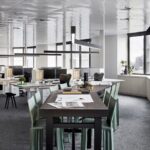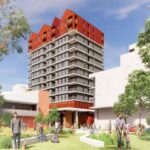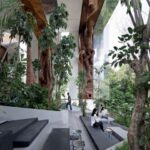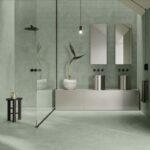Terrace house employs ‘creative adaptations’
Matt Gibson Architecture + Design presents its Fitzroy Bridge House as a way to celebrate the history and legacy of the original brick building.
Thus, the design process employs ‘creative adaptations’ to preserve the house‘s authenticity while enabling responsive family living, all along a challenging site.

GALLERY
The suburban fabric of the area is characterized by attached Victorian era housing, brickwork, chimneys, corbeled details, along with a ‘high solid to void ratio, distinctive rear service lanes with substantial boundary walls, and stable or loft structures.’
Drawing on these inspirations as ‘Melbourne’s earliest suburb, rather than introducing a newly attached contrasting addition, the architects craft a series of separate ‘Mews,’ or stable-like buildings, separated by courtyards.
With this strategy, the team seeks to ensure natural sunlight and ventilation reached the center of the long, narrow site. The connection between the old and the new is thoughtfully crafted so as not to compromise movement and light into these central spaces. While the project achieves this quality of openness, the light-filled spaces maintain privacy from neighbours peering down.
Matt Gibson Architecture and Design new massing of the Fitzroy Bridge House is novel to the historic neighborhood. The team notes: ‘Reinterpreting this massing — character not unknown to this site in earlier times — the programmatic objectives are similar with a series of three-by-two story buildings housing sleeping quarters above, with a linked open ‘living’ breezeway beneath containing flexible living spaces that straddle two internal courtyards.’
The main courtyard is flooded with sunlight by way of an elevated, glass-bottom bridge along with a walkway enclosed by a glass roof. The team writes: ‘Somewhat unconventional, this move unlocks the courtyard providing equal ability to aid privacy as it does aid solar access and a borrowed amenity between levels as one looks down over a manicured garden below inspired by the heritage of its owner.’
The project sees the preservation and restoration of the original street-facing brickwork façade. While the rear wing was demolished, all of its removed bricks have been salvaged and reused for the construction of the rear ’pavilions’ to ensure that ‘any new work came intrinsically out of the old.’ From the perspective of the side street, the three buildings are viewed in combination, unified by a ground-level wall, as well as by their textural materiality, colour, and solid expression.
The group continues: ‘The gesture of repeating a set of arched windows at the ends of each building (with expressed blinker hoods) are suggestive of traditional & local architecture, aiding in a consistency and connection between the buildings that is in keeping with the character of the neighbourhood.’
Images by Derek Swalwell via designboom
Studio Tate has completed a lavish redesign of the 17th floor of a distinctive hexagonal building in Melbourne, ...
Red sculptural interventions define the interior of ARKS’ new flagship store in Bandra West, Mumbai, where Anagram Architects ...
Work is set to begin on a new 12-storey mixed-use affordable housing development in Adelaide’s inner north-west, marking ...
Frame Garden Café, known as Tanatap, represents another prototype in an evolving series of multi-level greenspaces that challenge ...
Italian brand Casalgrande Padana has built a reputation as a prolific producer of ceramic and stoneware tiles, translating ...












